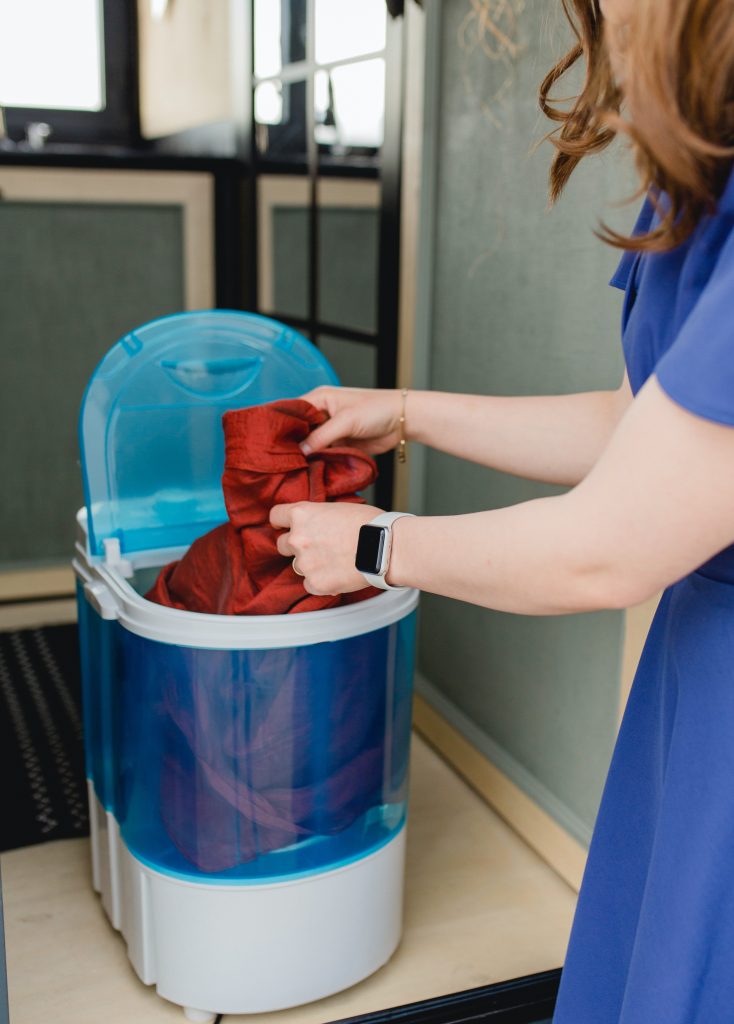Portable washing machines offer convenience and flexibility, allowing you to do laundry in small spaces or while traveling. However, when considering their usage, it is crucial to evaluate their electricity consumption.
So, the question arises: do portable washing machines use a lot of electricity? Understanding the power requirements of these compact washers is essential for making informed decisions and managing energy usage effectively.
While portable washing machines consume less electricity than their full-sized counterparts, their energy efficiency can vary depending on the model and settings.
By exploring the electricity usage of portable washing machines, you can make environmentally conscious choices without compromising cleanliness and convenience.
Let’s start and discover more!

Do Portable Washing Machines Use a Lot of Electricity?
No, portable washers use somewhat less electricity than regular ones. The energetical usage of portable washers is between 200-700 watts, while regular washers consume from 400 to 1,400 watts.
However, the electricity bill cost has little or almost nothing to do with the type of washing machine you use. Generally, it depends on how often you use it and, most importantly, the type of program and its longevity.
Portable washing machines use less electricity because they are smaller, and you can only make smaller loads. The motor and the heating coil demand the most power, so using your washer on a cold washing cycle can help you save some on your electricity costs.
What Exactly Consumes Most Energy While Using a Washing Machine?
First, let’s look at what consumes electricity in a typical washing machine.
- The motor that rotates the drum during the washing cycle, rinsing, or spinning cycle.
- The heating coil that heats the water during the hot wash cycle.
- The water pump that is used to drain the soiled water.
- A regular washing machine plugs into a regular 120-volt outlet. Depending on your program cycle, the new high-efficiency kind draws around 800-1200 watts peak.
In the entire washing process, what consumes the most electricity is the motor performing the front and reverse motion, consuming power for heating the water to safely derive this function.
The wash and rinse cycle consumes more electricity since it’s performed multiple times and requires more current.
You can use the true-power meter to check the amount of electricity your portable washer consumes. Most of the time, the washer manual states certain claims that aren’t always accurate.
Are Portable Washers Economical?
Portable washers are more economical if you use them on a cold washing cycle
Do portable washing machines use a lot of electricity? A portable washing machine is just as its name implies – a smaller version of a regular washing machine that can be easily moved around your living area or stored aside when you aren’t using it. What this means is that it’s almost the same as the standard washer, with somewhat smaller features.
The electricity usage also largely depends on whether you are using it on a hot water cycle or a cold water washing cycle. When you run a hot water cycle, the washer uses heating elements that consume significantly more power.
Read more: Do Washing Machines Use A Lot Of Electricity?
Portable washers are more economical if they aren’t connected to the electricity circuit all the time
One of the many advantages of portable washing machines is the fact that they are, well, mobile. This means that they aren’t connected to the electricity circuit all the time.
Even though it seems like it doesn’t influence much, all appliances connected to the electricity circuit consume energy even when turned off.
Also read: What Type Of Washing Machine Lasts The Longest?
Types of Washing Machines and Electricity Consumption Rate
Whatever the type of washing machine, it runs on electricity, so using it will raise the electricity bill one way or another; however, it largely differs in its work mechanism.
- Semi-automatic washers are the cheapest, causing low costs, probably between 0.5 to 1 unit of electricity per wash.
- Top-loading automatic washers without a water heater consume approximately 1 unit per day.
- Front-loading automatic washer with a water heater uses an internal water heart that consumes the most electricity compared to the other types of washers. The main reason for this is that they are more powerful and spin at 800/100/1,200 rpm, depending on what cycle you are using. The quick cold cycle wash will consume about 0.25 units, while the regular cycle can consume 1-1.5 units per cycle.
- Portable washers consume approximately 400 to 1,300 watts of energy. Despite all the similar functions to traditional washers, they are a more efficient option if you want to implement a low-cost strategy in your home.
Conclusion
So, do portable washing machines use a lot of electricity? Portable washing machines do not use a lot of electricity compared to regular washers.
The energy usage of portable washers typically ranges from 200 to 700 watts, whereas standard washers consume between 400 and 1,400 Watts. However, the electricity cost is primarily determined by factors such as frequency of use and the program settings chosen rather than the type of washing machine.
Portable washing machines are designed to be smaller and accommodate smaller loads, resulting in lower energy consumption. You can reduce electricity costs by utilizing cold-washing cycles and being mindful of the motor and heating coil.
It’s important to note that the efficiency of a washing machine is not solely dependent on electricity usage but also on other factors such as water consumption and overall performance.
Overall, portable washers offer an economical option for those seeking to minimize their electricity expenses while maintaining effective laundry cleaning.







